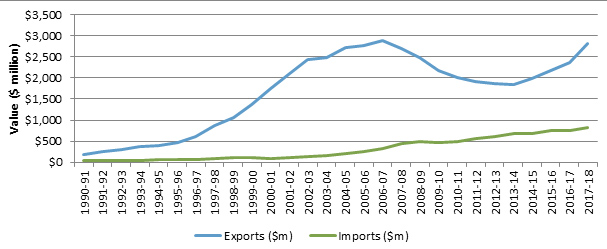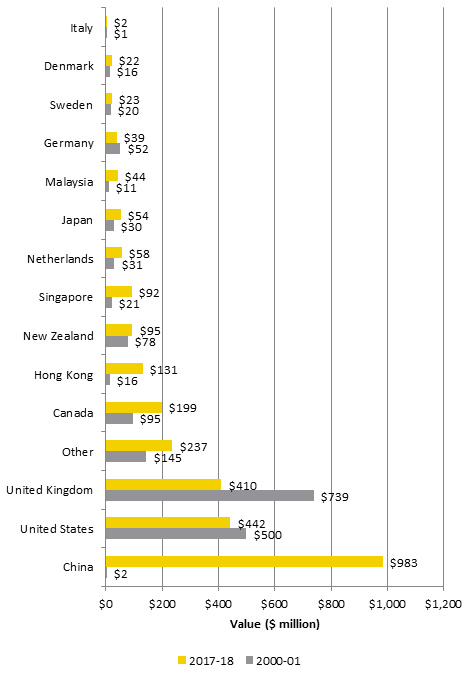Introductory Info
Date introduced: 2 December 2019
House: Senate
Portfolio: Agriculture
Commencement: On the earlier of a single day fixed by Proclamation or 12 months after Royal Assent.
Purpose of
the Bill
The purpose of the Wine Australia Amendment (Label
Directory) Bill 2019 (the Bill) is to amend the Wine Australia Act
2013 to enable Wine Australia to establish and maintain a publicly
available directory of grape product labels intended for export (Label
Directory).
Background
Australia’s
wine export industry
According to the Australian Bureau of Agricultural and
Resource Economics and Sciences (ABARES), during 2017–18 Australia produced 1.7
million tons of wine grapes, consumed 492 million litres of wine (approximately
19.7 litres per person), exported 866 million litres of wine to the value of
$2,828 million and imported 100 million litres of wine to the value of $827 million.[1]
The wine export market is becoming increasingly important
for Australia. Figures 1 and 2 below show how both wine exports and wine imports
have increased. However, exports have increased more rapidly than imports.
Figure 1: wine
imports into Australia and wine exports from Australia 1990–91 to 2017–18

Source: Department of Agriculture,
Australian Bureau of Agricultural and Resource Economics and Sciences (ABARES),
‘Agricultural
commodities and trade data’, ‘Agricultural
commodity statistics: 2018: Rural commodities – wineXLXS’, ABARES website, last reviewed 16 December
2019.[2]
Figure 2: wine import values into Australia and wine export values from
Australia 1990–91 to 2017–18

Source: Department of Agriculture, Australian Bureau of
Agricultural and Resource Economics and Sciences (ABARES), ‘Agricultural
commodities and trade data’, ‘Agricultural
commodity statistics: 2018: Rural commodities – wineXLXS’, ABARES website, last reviewed 16 December
2019.[3]
Establishment
of Wine Australia
The Wine Australia Act establishes Wine Australia
as a statutory authority.[4]
Its functions include controlling the export of grape products[5]
from Australia and anything incidental to, or conducive to, the performance of
any of its functions.[6]
Export control
The Wine Australia
Regulations 2018 (the Regulations) prescribe controls:
- to
ensure the quality of grape products that include Australian wine and are
exported
- to
implement Australia’s international obligations and
- to
ensure Australian wine that is exported complies with importing country
requirements.[7]
The export of grape products, including wine, from
Australia is subject to three steps:
- first
a grape product must be approved for export by an exporter.[8]
Wine Australia may approve the grape product if it is satisfied of all of the
following:
- either
the grape product complies with the Australia New
Zealand Food Standards Code or the nature of the non-compliance will not
compromise the reputation of Australian grape products
- the
grape product is sound and merchantable and
- the
description and presentation of the grape product is appropriate having regard
to requirements of the Act, other Australian laws and the laws of other
countries[9]
- second,
once a grape product is approved, Wine Australia is empowered to grant an
export licence to an exporter[10]
and
- third,
Wine Australia issues an export certificate in respect of the consignment of
the grape product.[11]
The Wine Australia Act creates offences:
- under
Part VIA where a person fails to comply with the label integrity program[12]
and
- under
Part VIB where a person sells, exports or imports wine in trade or commerce and
with a false description and presentation.[13]
Rationale for the Bill
Despite these legislative controls on the export of wine,
on 17 November 2017, it was reported that ‘Police in Shanghai have seized
14,000 bottles of fake Penfolds wine being sold by counterfeiters’:[14]
The three-month investigation followed a complaint to Alibaba
by Australian wine company Treasury Wine Estates that suspicious retailers were
charging ‘‘extraordinarily low prices’’ for Penfolds wine in its
fastest-growing market ...
A Shanghai-based marketing consultant ... said fakes were ‘‘an
absolutely critical issue’’ for Australian brands because they risked brand
integrity ...
Brands that are high in value and demand, such as Penfolds,
are more likely to be a target.[15]
The Bill empowers Wine Australia to establish and maintain
a directory of labels that are attached to grape products such as wine intended
for export from Australia (the Label Directory), as a part of Wine Australia’s
export controls.
According to the Explanatory Memorandum to the Bill:
The purpose of the Label Directory is to deter exports of
copycat wine ... from Australia. Copycat grape product exports are products that
are exported from Australia with labels that seek to mimic elements of
Australian brands for commercial gain and unfairly benefit from the reputation
of those brands. These labels may contain trademarked intellectual property
(IP) elements, infringing on the private IP rights of Australian brands.[16]
The introduction of this legislation is timely in the
light of the expansion of the number of countries to which Australia exports
wine. For instance, in 2000–01, Australia’s major wine export destinations were
the United Kingdom (UK) and the United States of America (USA). However, by 2017–18
the composition of Australian wine export markets shifted to China and
south-east Asia. This is illustrated in Figure 3 below.
Figure 3: Australia’s wine export destinations 2000–01 and 2017–18

Source: Department of Agriculture, Australian Bureau of
Agricultural and Resource Economics and Sciences (ABARES), ‘Agricultural
commodities and trade data’, ‘Agricultural
commodity statistics: 2018: Rural commodities – wineXLXS’, ABARES website, last reviewed 16 December
2019.[17]
Committee
consideration
Senate Selection
of Bills Committee
At its meeting of 4 December 2019, the Senate Selection of
Bills Committee recommended that the Bill not be referred to Committee for
inquiry and report.[18]
Senate
Standing Committee for the Scrutiny of Bills
At the time of writing this Bills Digest, the Senate
Standing Committee for the Scrutiny of Bills had not commented on the Bill.
Position of
major interest groups
Public consultation was undertaken by the Department of
Agriculture on the proposal to develop the Label Directory from 21 September
2018 to 19 October 2018.[19]
The results of the consultation have not been made publicly available; however,
according to the Explanatory Memorandum:
... the majority of submissions from the wine industry broadly
supported the need and proposed model for the Label Directory. Following this
consultation, the Department [of Agriculture] further refined the proposal with
Wine Australia and AGW [Australia Grape and Wine]. The Department of the Prime
Minister and Cabinet, and IP Australia were also consulted.[20]
Financial
implications
The Explanatory Memorandum states that the Bill will have
no financial impact on the Australian Government Budget.[21]
However, the development of the Label Directory will be
funded to the amount of $417,000 from the Export
and Regional Wine Support Package.[22]
This package is not supported by levies, it is a budget item under the Ten Year
Enterprise Tax Plan – wine equalisation tax rebate integrity and wine tourism
funding, where in the 2016–17 Budget the Government provided:
... $50.0 million over four years to the Australian Grape and
Wine Authority to promote wine tourism within Australia and Australian wine
overseas to benefit regional wine producing communities.[23]
Statement of Compatibility with Human Rights
As required under Part 3 of the Human Rights
(Parliamentary Scrutiny) Act 2011 (Cth), the Government has assessed
the Bill’s compatibility with the human rights and freedoms recognised or
declared in the international instruments listed in section 3 of that Act. The
Government considers that the Bill is compatible.[24]
Parliamentary
Joint Committee on Human Rights
At the time of writing this Bills Digest, the
Parliamentary Joint Committee on Human Rights had not commented on the Bill.
Key issues
and provisions
Establishing
the Label Directory
Item 6 of the Bill inserts proposed section 45A
into the Wine Australia Act to authorise the establishment of a Label
Directory. The provision allows the Regulations (made under section 46 of the Wine
Australia Act) to provide for the establishment, maintenance and public
availability of the Label Directory.[25]
The Label Directory authorised by the Regulations will not
be a legislative instrument.[26]
Contents of
the Label Directory
The Bill provides that the Regulations may include a
requirement that the Directory include digital colour images of grape product
labels and other information about grape products or relating to exporters of
grape products.[27]
According to the Explanatory Memorandum to the Bill:
In practice this information would be information for the purposes
of identifying the images of the labels in the Label Directory, and to enable
brand owners to identify who they would need to make an IP claim against if it
was considered that a label infringed the brand owner’s IP rights.
The kinds of information that is intended to be sought under
a regulation made for this purpose includes:
- the brand
and grape product name and
- the exporter name, business address
and business identifier (e.g. Australian Business Number, Australian Company
Number or Australian Registered Body Number) of the grape product exporter.[28]
In addition, the Bill allows the Regulations to provide
for the inclusion of personal information on the Label Directory—provided that
the personal information:[29]
- is
included in a digital colour image of grape product labels or
- relates
to grape products or exporters of grape products.[30]
The Explanatory Memorandum states:
This information is also required to be included on the label
affixed to grape products itself under the Australia New Zealand Food
Standards Code, so would be the kind of information that is already
available to purchasers of grape products within Australia and within the
intended export markets.[31]
The Bill also requires that the Regulations include a provision
for corrections to the contents of the Directory.[32]
Use of the
Label Directory
Wine Australia is authorised to use the contents of the
Label Directory:
- in
order to decide whether there has been a contravention of the label integrity
program (in Part VIA of the Wine Australia Act) or
- to
perform its functions, or exercise its powers, under the Wine Australia Act
or the Wine Australia Regulations.[33]
Consequential
amendments
Consistent with the amendments in proposed section 45A, item
2 of the Bill inserts a new definition of the term grape product
label, being a label attached to, or writing or other sign appearing on,
a bottle or other package of a grape product. In addition, item 3 of the
Bill repeals and replaces the definition of package in subsection
4(1) of the Wine Australia Act so that the package, in relation to a
grape product, is a container in which the grape product is sold or transferred
for sale.
According to the Explanatory Memorandum to the Bill:
With establishment of the Label Directory, it is intended
that exporters of grape products would be subject to additional requirements as
a condition of the export controls administered by Wine Australia under Part 3
of the current regulations. The addition of [the new definition of grape
product label] would assist exporters of grape products to understand
the information they will be required to provide when asked to submit digital
colour images of grape product labels under the current regulations. Further,
this definition will assist Wine Australia in enforcement of the Label
Directory.[34]